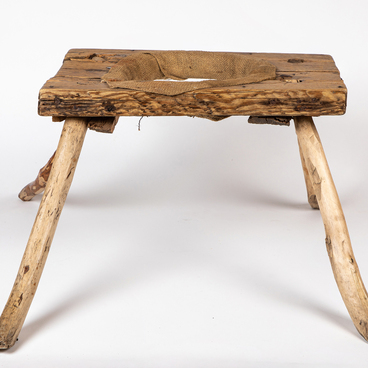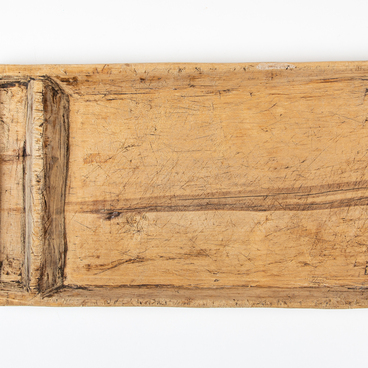The collection of the Sheltozero Veps Ethnographic Museum named after Rurik Petrovich Lonin features a spinning tool — a device designed to manually spin one strand of yarn. The object was found in an uninhabited old house in the village of Sheltozero and subsequently donated to the museum. This manual one-piece spinning tool is made from the root and trunk of a tree.
Since ancient times, the spinning wheel was a symbol of women’s craftsmanship. Each housewife had to provide her family with clothes, so all winter months, from harvesting to the beginning of agricultural work, women spun. Hand spinning was a rather slow process. The carded flax fiber (tow) was tied in the upper part of the distaff (blades), a woman sat on the seat (bottom) mounted on a bench, and with her left hand carefully pulled the thread out of the “beard” (lower part of the tow). The craftswoman twisted it, and with her right hand wound this thread onto a rotating spindle. It took a lot of dexterity, patience and skill to make the thread thin, smooth and durable: if pulled a little harder — it would break, and a little weaker — it would be too thick or uneven.
Perhaps no single tool of peasant labor was
decorated in such a variety and with such love as a distaff. Of course, such an
exquisite object not only adorned a peasant’s hut, but also warmed the heart of
the craftswoman and brightened up the endless monotonous work. From the age of
five, girls began to learn needlework: they were allowed to spin a thread of
coarse wool. The girl began spinning and preparing her dowry at the age of
eight. The spinning tool was a valuable gift: the father gave it to his
daughter, the groom to the bride, the husband to his wife. Spinning tool
manufacture was a man’s occupation, but spinning was purely feminine. It was
believed that if a man touched a spinning tool, he would lose strength and
dexterity. But spinning was not considered a tedious duty. The girls often
gathered together to sing songs while spinning. Young men came to look at the
girls at work. They proposed to the one who could spin well. Such a girl was
considered a good housewife. After finishing the work, when the whole tow
turned into a thread, the girls could relax: it was customary to participate in
round dances (khorovod).


